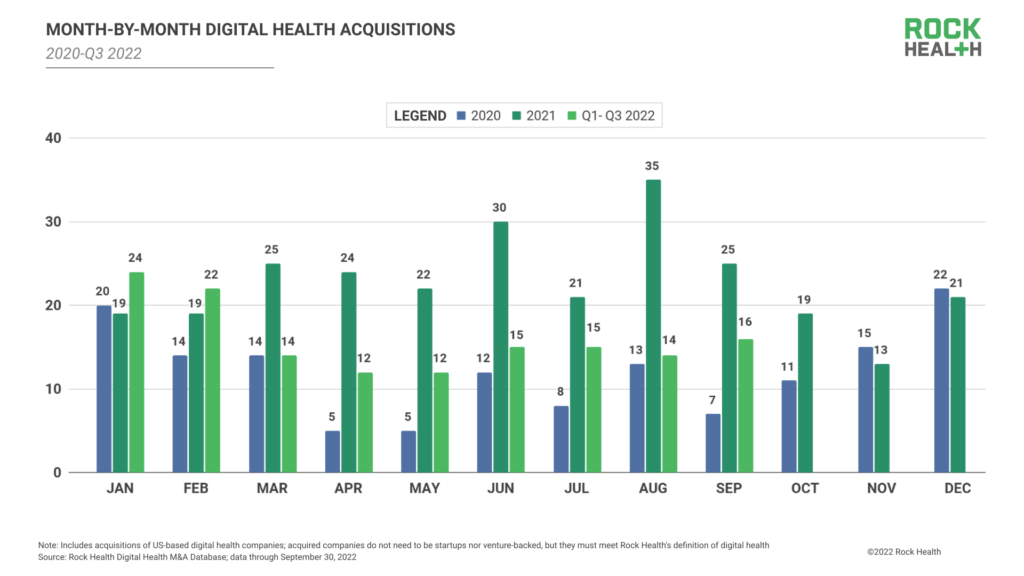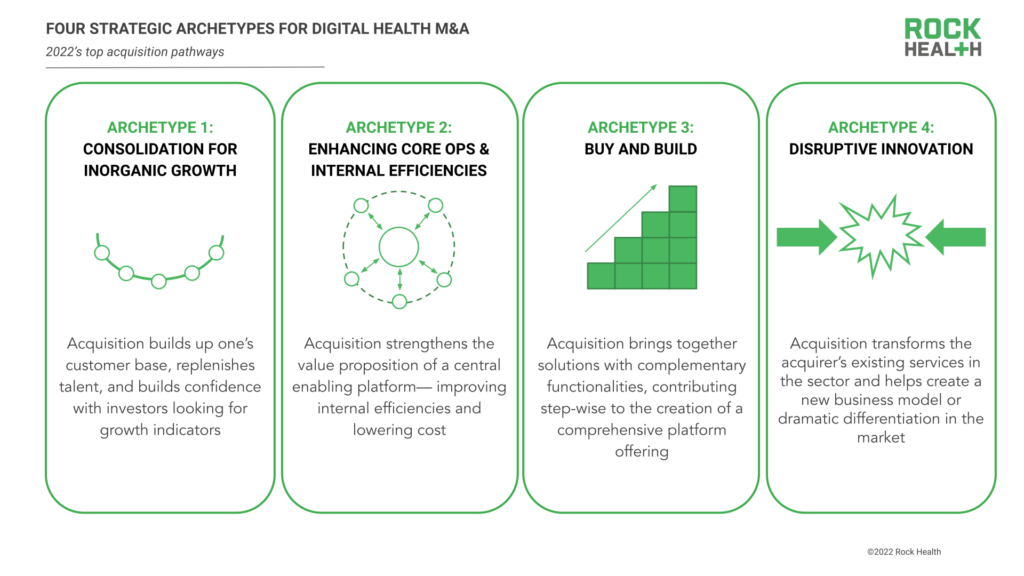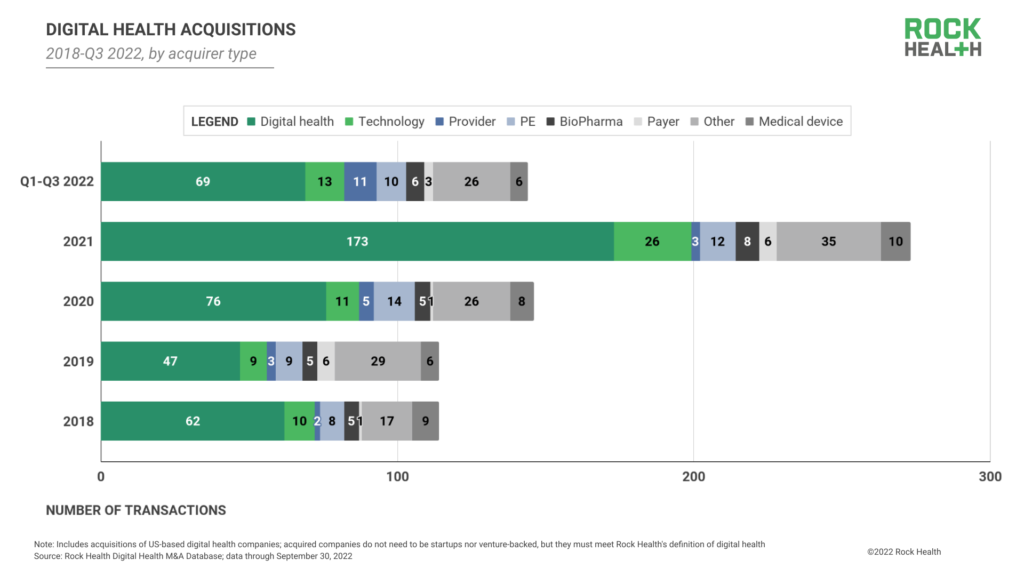It takes two: Exploring 2022 digital health M&A trends
The choppy waters of this year’s market have forced a significant slowdown in digital health investment, but buyers and builders alike are seizing the moment to consider mergers and acquisitions (M&A) as strategic opportunities. We’ve seen big ticket M&A deals1 dominate 2022’s healthcare news cycle, while valuation declines, customer overwhelm, and an unfriendly IPO market continue to raise expectations for growing digital health M&A activity—even compelling one company to issue a statement swatting down acquisition rumors.
In this piece, we explore the sell-side and buy-side dynamics that are making conditions ripe for M&A activity and dig into four M&A approaches being pursued by acquirers in this market moment. We’ll share recent examples for each approach, with an eye toward what each one tells us about the digital health sector today and how it might change over the next few quarters.
2022’s state of M&A: Sell-side and buy-side motivations
Similar to the overall state of funding, digital health M&A took off in 2021, averaging nearly 23 deals per month for an annual total of 273 deals—a trend that continued into the early months of 2022, with January and February also averaging 23 deals monthly. But as inflationary concerns, economic contraction, and global factors stifled venture funding in Q2 2022, the whiplash also hit M&A, with Q2’s average monthly deal count dropping to thirteen.

But unlike digital health venture funding—which hit its lowest quarter since 2019 in Q3 2022—M&A activity caught a small upswing in Q3 with an average of 15 deals per month, bringing total digital health M&A deals in Q1-Q3 2022 to 144. As Q4 closes and 2023 begins, we expect this climb to continue, in part due to sell-side dynamics. In today’s slower funding markets, digital health startups being squeezed by unfriendly fundraising conditions may be more likely to welcome M&A proposals that allow them to combine forces with other companies to bolster product offerings and teams, keep shared service costs down, and offer liquidity to impatient investors. And, context matters—these M&A options will look more appealing depending on the alternatives: down rounds or IPO uncertainties.
“Companies that foresee a capital shortfall before they reach profitability will have to be willing to look at a range of alternatives to bridge that funding gap. And while I would not say that a deal is going to get done purely because a company needs cash, it is one factor that could tip the scales in favor of a transaction in today’s environment.”
— Danika Fry, Executive Director, Healthcare Investment Banking at Morgan Stanley
Startup exit motivations via M&A are complemented by buyer demand. We’ve identified four archetypes of digital health buyers capitalizing on sell-side interests to meet the following operational or strategic needs: 1) consolidation for inorganic growth, 2) acquisitions to enhance core operations and internal efficiencies, 3) “buy-and-build” deals for category expansion, and 4) M&A for disruptive innovation.

M&A archetype 1: Consolidation for inorganic growth
As some digital health startups contemplate exiting the private market to avoid an austere funding climate, others are looking to weather the market by acquiring their competitors—leading to waves of sector consolidation.
From the buyer’s perspective, consolidation is a useful approach to grow one’s customer base and build confidence from investors looking for growth indicators. Particularly at a time when digital health players are balancing tightening purse strings with rising customer acquisition costs, organic growth can be difficult—but acquiring competitors with additive customer bases grows their audience and secures market share, better positioning the acquirer for when the market rebounds. For example, virtual alcohol use disorder support program Monument acquired its competitor Tempest in May. The deal expanded Monument’s total patient population from 30,000 to over 300,000 and positioned Monument to grow its personalized and holistic care offerings, building on work that the Tempest team had already set in motion.
Consolidation has been an ongoing dynamic in digital health, especially in crowded areas such as digital mental health, with abundant point solutions that are often difficult for customers to navigate. Q1-Q3 2022 already logged 69 M&A deals with digital health companies acquiring other digital health companies, and we expect this number to grow as targets consider adjusting their valuations (i.e., buying prices) to entice more potential suitors. Even growth-stage digital health startups watching their bottom lines could get in on the acquiring action. While acquisitions can incur large upfront costs, they set acquirers up for more fundraising potential in the future. Both founders and investors may see this form of consolidation as a risk worth taking.
“There’s a lot of consolidation happening in digital health. Growth-stage companies are evaluating M&A targets that can help to achieve scale, increase patient volume, add new specialty areas, and make moves into value-based contracting.”
— Kuldeep Singh Rajput, Founder and CEO, Biofourmis
M&A archetype 2: Acquisitions to enhance core operations and internal efficiencies
The second acquisition strategy involves purchasing digital health startups that enhance or streamline the acquirer’s core operations, ideally offsetting the cost of acquisition with the bottom-line savings that would result from new internal efficiencies. Interestingly, many acquirers pursuing this type of M&A approach are provider organizations, which are battling staffing cost surges and rollbacks in post-pandemic relief funding. Despite feeling the cash squeeze, provider organizations announced 11 M&A deals between Q1-Q3 2022, already surpassing 2021’s total three-fold.

When cash is tight, why acquire? For some provider organizations, it’s likely that the efficiencies gained by bringing in a digital health solution and corresponding team (possibly at a depressed price) outweigh the cost of proposing and staffing an internal platform build. If synergies already exist—potentially from a prior partnership—acquisition may be the lowest-barrier path to core upgrades at a time when internal, ground-up initiatives are being cut or eliminated altogether.
Not all operations-minded acquisitions are made by provider organizations, but deals in this M&A archetype tend to feature targets that innovate at the backbone of provider operations, in areas such as data analytics, interoperability, infrastructure, clinical and nonclinical workflows, and consumer engagement. Across all acquirer types, digital health startups offering data integration and analytics capabilities were the top acquisition targets from Q1-Q3 2022 with 17 targets purchased, including New Directions Behavioral Health’s acquisition of behavioral health analytics software Tridiuum, as well as direct healthcare provider Nomi Health’s acquisition of benefits analytics platform Artemis Health. Digital health startups advancing patient engagement capabilities and supporting EHRs and clinical workflows followed as the the second and third-most acquired company types with 15 and 14 deals respectively. Examples include VillageMD’s purchase of patient engagement solution Healthy Interactions in February, as well as Biointellisense’s acquisition of patient monitoring workflow software AlertWatch in October to improve capabilities for operating rooms, labor and delivery units, and ICUs. This focus on acquiring targets that improve provider efficiencies mirrors growing venture investment in backend functionalities, including health data infrastructure and nonclinical workflow solutions.
M&A archetype 3: Buy and build for complementary features
A third acquisition strategy involves buying digital health companies with features complementary to the acquirer entity—empowering the acquirer to move more freely upstream or downstream in the care delivery value chain. This stepwise strategy can help acquirers capture market share in adjacent care categories. As one example, diagnostics leader Quest Diagnostics bought Pack Health in January, pushing Quest beyond testing into patient engagement and condition management. Similarly, virtual care suite Recuro Health extended into primary care by purchasing WellVia in April and then entered the employer benefits space by acquiring Competitive Health in August. This buy and build approach is also helpful in extending care networks virtually or into the home, exemplified by Advocate Aurora Health’s acquisition of remote patient monitoring startup MobileHelp in April, propelling the health system into home health and the aging in place.
M&A archetype 4: M&A for disruptive innovation
The fourth acquisition strategy in M&A encompasses some of the headline-making deals we’ve seen this year—acquisition for disruptive innovation. For this analysis, we define “disruptive” deals as those that 1) transform (or jumpstart) an acquirer’s existing digital health services and 2) position the acquirer to create a new business model or drastically differentiate in the market. So far, disruptive deals in 2022 include the well-publicized Amazon purchase of One Medical, CVS stepping into home care with Signify, and Walgreens finalizing its complete ownership of Shields Health.1 Although we have yet to see whether these deals have proven to be truly disruptive, we’re keen to see how their ripples turn to waves in the coming quarters.
Who is best positioned to make the next set of disruptive acquisitions? As interest rates have continued to soar, the relative cost of capital has increased in tandem. With the days of easy money in the rear-view mirror, we hypothesize that the players best positioned to make headline-grabbing M&A deals are primarily those who used the heady times of 2021 to accumulate and hold serious cash reserves. In particular, Big Tech, private equity, and biopharma firms have profited handsomely over the past two years and have a rich history of holding their cash-reserves for tax, R&D, and M&A initiatives. We anticipate more of these dollars will flow into disruptive acquisitions over the next year as valuations begin to fall to buy-side expectations. Technology acquirers already led 9% of digital health M&A activity by deal volume in Q1-Q3 2022 (tech acquirers’ busiest acquisition period in digital health since 2019), while private equity and biopharma acquirers accounted for 7% and 4% of Q1-Q3 deals, respectively. We’re expecting these players’ M&A roles to grow into 2023.
What digital health targets are on the menu for the cash-rich? Prime targets are value-depressed late-stage companies that have established product-market fit and teams with deep vertical-specific knowledge. These companies have often done much of the legwork in demonstrating important clinical evidence and building user bases, but may struggle with business model challenges. However, enterprise acquirers are likely to view these circumstances as opportunities to buy-in at a lower multiple and use their scale and organizational know-how to achieve profitability. Yet headwinds remain, especially on the valuation and regulatory fronts. Despite some modest adjustments over the past six months, we’re hearing that high valuations continue to be deal breakers (even for some major players). A lesser, but still notable factor is the impact of regulatory scrutiny on dealmaking, which can tie up deals in thickets of red tape.
A final area to watch is for the entrance of new names on the buy-side, as nontraditional but cash-rich segments (including some “middle children”) seem poised to represent an emerging breed of digital health disruptors. Acquirers that are not categorized as providers, payers, biopharma, med device, or digital health companies—a category we define as “other”—were engaged in approximately 18% of total digital health M&A deals from Q1-Q3 2022, compared to their 13% representation in 2021. This trend hints at the increasing relevance of new actors (ahem, retail players) testing healthcare’s waters by acquiring digital health startups. Making these strategic inroads in digital health can create new and diversified opportunities for non-traditional players to disrupt the status-quo.
M&A heyday or mayday? Acquisition is just the first step
With these archetypes as scaffolding, the next several quarters of M&A activity will shape, and possibly shake up, the digital health landscape—consolidating point solutions in crowded markets, improving efficiencies at provider organizations, building out new platform capabilities, and disrupting the status quo through big-bang deals that push into new horizons. However, deal announcements aren’t the end of the story. Successful M&A approaches are determined by important choices (e.g. how best to integrate tech stacks as well as cultures and operations, what to keep and where to cut bait, workforce strategy, etc.) and hard work post-announcement as much as they are by the targets, timing, and strategy behind dealmaking. While today’s winds of change present immense opportunity to make both disruptive and necessary acquisitions, assessing these frameworks alongside financial, cultural, and operational aspects of M&A is necessary to help organizations—both acquirer and target—maximize impact.
Rock Health Advisory helps teams at major corporations understand and act on opportunities in digital health’s evolving landscape through our consulting practice and membership program. If you’re interested in better understanding how your organization should approach digital health M&A decision- making or navigate M&A waves in the healthcare market, reach out to advisory@rockhealth.com.
Footnote
1. Rock Health tracks M&A deals in which the target firm is a US-based company that meets our definition of digital health. For this reason, other healthcare M&A deals such as Amazon’s acquisition of One Medical are not tracked in our M&A database.


